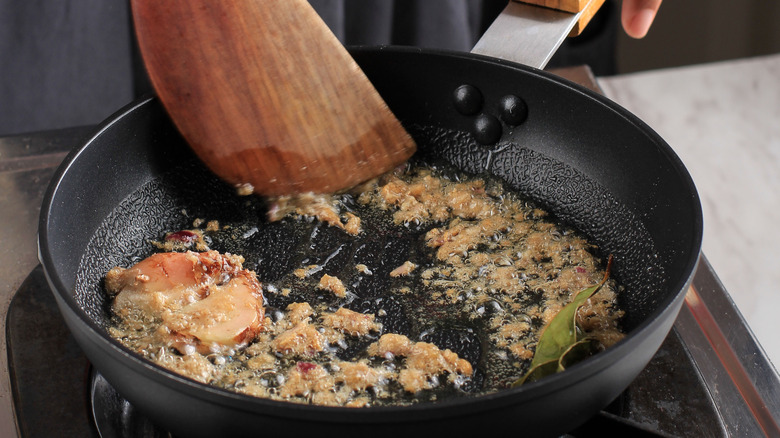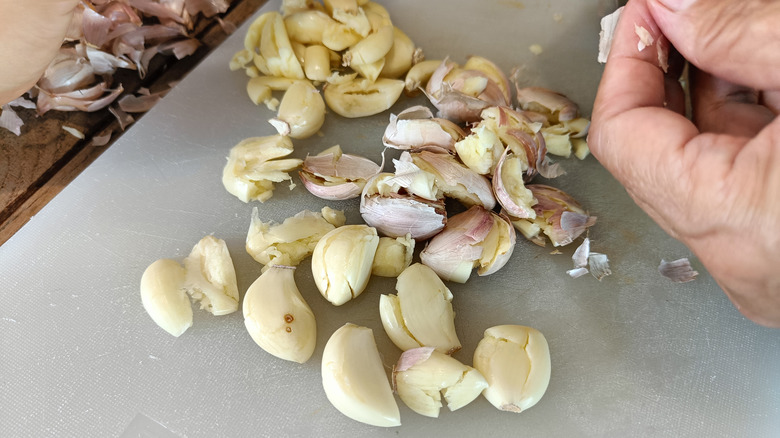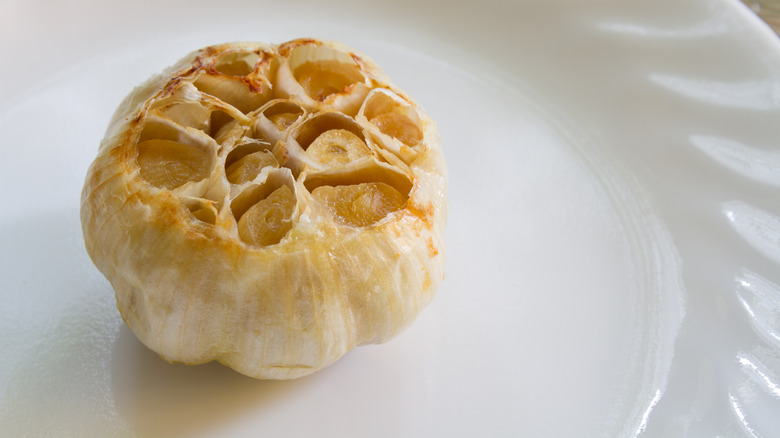A Cold Pan Is The Key For Never Burning Garlic Again
One of the most common kitchen scenes on the big screen is someone cooking at a stove with a fancy burst of flames popping from the pan. In real life, the only time that you'll see a chef with a flaming pan is if they're either specifically using a technique called the flambé, which is adding a flammable alcohol to a very hot pan to burn off the alcohol and leave the subtle flavor of the spirit behind, or if they've made a mistake and left the pan on the heat too long.
In real-life kitchens, there's not a lot of flambéing going on. It's only used for specific recipes like Bananas Foster. It just happens to look cool so it's overrepresented in stories that involve cooking and chefs. Unfortunately, the overabundance of flambé scenes can lead people to believe that's what sautéing actually looks like. Good old sautéing, however, doesn't have a lot of visual wow factor if you're doing it right. Sautéing is when you cook something quickly, "over fairly high heat." The emphasis here is on the word fairly, because a lot of people crank up the gas and sauté too hot, which will burn delicate ingredients like fish, herbs, and most especially, garlic.
Start with a cold pan
One of the most common mistakes people make when cooking with garlic, especially when it's chopped, is cooking it in a hot pan. When garlic is alone in a hot sauté pan it can take only a few minutes — or even seconds — for it to turn from nicely diced bits into burnt crumbles. This is because small pieces have more surface area and cook very quickly. If your pan is so hot that your oil or butter starts to smoke when you add it to the pan, pull it off the heat and let it come down to a lower temperature before you add the garlic. Better yet, don't preheat the pan, instead use a cold pan on the stove, add your fat and garlic, and then turn on the heat. Start your garlic on a lower heat and then turn it up as needed.
If you're making something with a bed of diced or sliced onions and other veggies, like a stir fry, add the garlic to the pan after you let the other vegetables cook a little bit. The bed of vegetables will act as a heat buffer to keep your precious garlic bits from crisping up. If you do burn the garlic, you can toss it, wipe out the pan and start over. Unless of course, you enjoy burnt garlic, as some people do.
Watch your oven temps, too
Temperature is just as important when you're roasting garlic in the oven to make soft, spreadable cloves for recipes like garlic bread or Crock-Pot Sopa De Ajo (Castilian Garlic Soup). Just like sautéing, a lot of people make the mistake of roasting food, especially vegetables, at too hot of a temperature, which results in veggies that are burnt on the outside and undercooked on the inside.
Roast your garlic at around 375 degrees Fahrenheit. You can also place your garlic bulbs in the oven before it gets up to temperature, which is like starting with a cold sauté pan. The bulbs should be ready in about 30 to 40 minutes, but when you start smelling garlic you should check on your cloves periodically by squeezing them with a pair of tongs to see if they're getting soft, and then pull them out so that they don't burn.
Sometimes you can get away with over-roasted vegetables because carrots and onions have some sugar in them that caramelizes and still tastes good. Garlic, on the other hand, has little to no sugar or starch so it tastes acrid and bitter when it's burnt, and while there are a few ways that you can lessen the garlic's flavor if you haven't gone too far, it's of course always better to avoid burning anything in the first place. Just keep the temperature in your pan and oven low and you'll never burn your garlic again.


